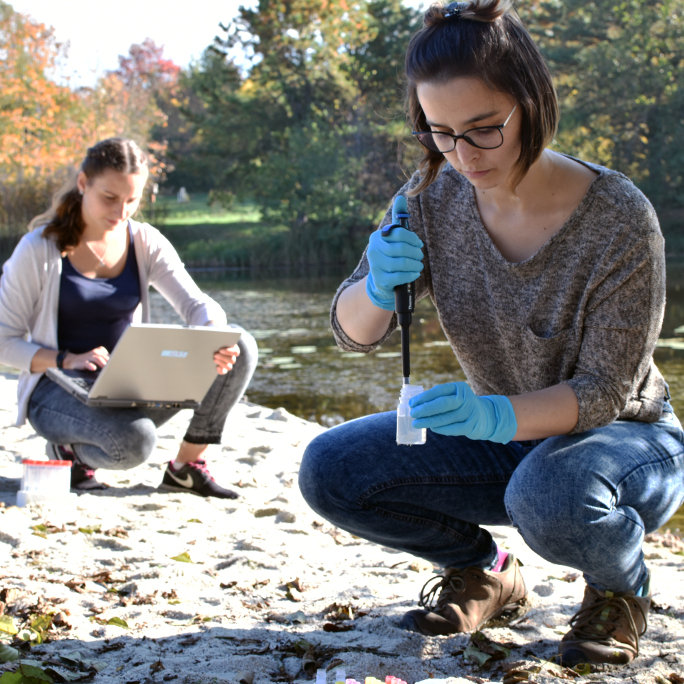Research thrives on diversity, and Bavaria is home to a wide range of research institutions. Find out about our excellent research universities and universities of applied sciences, as well as the organizational structures that are common at Bavarian universities.
Types of Universities
Universities in Bavaria promote academic and scientific advancement across a range of disciplines. Whether they are research universities, or universities of applied sciences, all Bavarian institutions foster collaboration and innovation in distinct ways. Most importantly, they are all committed to education and research.
Research Universities
Research universities conduct research in a wide range of academic disciplines. Depending on the specific institution, certain disciplines might be more prominent than others.
Traditional Research Universities
These universities conduct basic as well as applied research across disciplines, including the humanities, law, science, engineering, and medicine. The importance of basic research and its integration into teaching and learning is the defining characteristic of Bavarian research universities. However, the approach to research and teaching at a research university includes both theoretical and applied methods.
This concept is known as the Humboldtian model and dates back to the 19th century. Encouraging academic freedom and a strong connection between education and scientific discovery, it became a prominent academic principle worldwide. To this day, it is a core principle of Bavarian universities.
Technical Universities
Technical universities traditionally specialize in research in the fields of engineering, technology, and applied and natural sciences. They typically provide state-of-the-art research facilities and emphasize innovation. Bavaria boasts two technical universities, the Technical University of Munich (TUM), and the University of Technology Nuremberg (UTN).
Increasingly, scholars are recognizing that technology is not just a product of scientific research but is embedded in society. As a result, the research networks at technical universities worldwide are expanding to include many other disciplines. TUM, for instance, is developing its technology-related research in the humanities and social sciences. This crossover holds true for traditional research universities as well: Friedrich-Alexander-Universität Erlangen-Nürnberg is a research university with a strong focus on engineering and science.
Universities of Applied Sciences
Universities of applied sciences (UAS), or Hochschulen für angewandte Wissenschaften, focus on the practical side of research and education. They offer traditional research fields such as engineering, business, and social work. Universities of applied sciences are usually smaller than research universities and place greater emphasis on teaching and applied research.
Bavaria currently has 17 public universities of applied sciences. Many of these have a strong focus on applied technology and innovation and thus carry the added distinction of being a Technische Hochschule (technical university of applied sciences).
Recently, many UAS have been granted a subject-specific right to confer doctoral degrees. Through cooperation with research universities, they may also supervise and train doctoral candidates in other subjects. The UAS do not follow a chair-based structure. If you aim for a professorship at a UAS, you usually need to have a doctorate and several years of professional experience outside of the university. However, within the framework of a UAS Junior Professorship (Nachwuchsprofessur), you may also acquire either the doctorate or the necessary professional experience while being employed at the UAS.


University Structures
Bavarian universities have their own particular organizational structures, some of which may be unfamiliar to international researchers. To help you navigate your way around Bavarian universities, here are some of the structures you might encounter when starting your research career in Bavaria.
"Fakultäten", Departments, and Schools
Across universities, the names for divisions can vary considerably. Bavarian universities are generally divided into Fakultäten, often translated as “faculties,” or “departments.” These are the principle administrative divisions responsible for research and teaching within a given discipline.
Important decisions are carried out at faculty level. Faculties set the examination regulations and curricula for bachelor’s and master’s degree programs according to the general regulations established by the university. The faculties also award doctoral degrees.
With new structures like “schools” or “activity fields”, some universities promote interdisciplinary collaborations and create synergies between disciplines.
The "Lehrstuhl" or Chair
Often translated as “chair,” a Lehrstuhl is a kind of subdepartment at a university. Usually, a single professor leads the Lehrstuhl, which consists of professors, research assistants, doctoral candidates, student aids, and administrative staff.
If you are applying for a PhD position or a postdoc position, you might need to apply directly to a professor in a chair, rather than the institute or department. Contact the Lehrstuhl secretary for general information about the application process or other administrative matters.
Commitment to Education
If you are pursuing a university career with the goal of becoming a professor, you will be interested in gaining experience both as a researcher and as a teacher. Postdoc and PhD positions at universities, unless they are financed through third-party funds, have a teaching component. The teaching load will depend on your specific position. And don’t worry if German isn’t one of your languages: with a growing number of degrees offered in English, there’s a possibility you will be able to teach your course in English.
Support for developing teaching skills
Universities increasingly offer teaching-methods workshops and other pedagogical training opportunities. They are a great way to develop your teaching skills and demonstrate your commitment to education. Check with your chair or faculty to find out about possible support.
Teaching Load and Expectations
Job postings will sometimes mention how much teaching is expected for a given position (although for some positions, there is no teaching requirement at all). German universities calculate teaching load by the number of contact hours per week (Semesterwochenstunden, SWS or Lehrveranstaltungsstunden, LV). If you see a position advertising "4 SWS," that means you might teach, for example, two courses that run for two teaching hours each week.
Average Weekly Teaching Load
Research Universities:
- Postdocs and PhD candidates: 5 SWS. If teaching is not a requirement of your position but you would like to gain teaching experience, you might be able to arrange this directly with your supervisor.
- Professors
Universities of Applied Sciences:
- UAS Junior Professorship (Nachwuchsprofessur): 6 to 9 SWS
- Professors at Universities of Applied Sciences: 18 SWS



